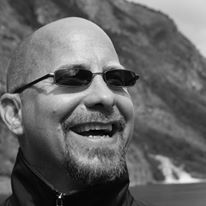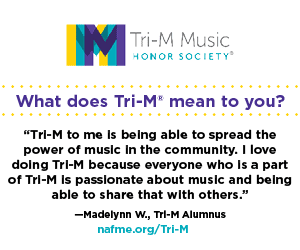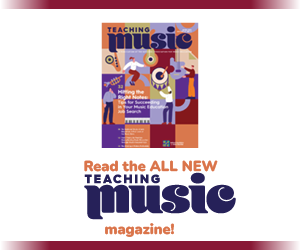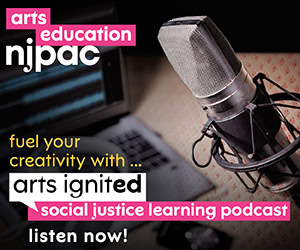/ News Posts / The Practice: Improvement Is Always Possible
The Practice
Improvement Is Always Possible
By NAfME Member Edward Varner, Ed.D.
This article was first published on Edward Varner’s Creating Hope blog.
Practice Makes Perfect
Perfect Practice Makes Perfect
There is no perfect—Practice for improvement. Improvement is always possible.
We’ve all heard the inaccurate expression that “practice makes perfect.” Some prefer to propagate the equally fallible variation that “perfect practice makes perfect.” In reality, however, there is no such thing as perfect. By suggesting that perfect might be achievable if we only try hard enough, or practice in a better way, we are condemning ourselves and our students to failure. Perfection is a myth. Improvement, on the other hand, is always possible and should be the goal of our practice. Improvement should be the goal in life, in education, in the creation of art, in work, and in everything that we do. None of us are capable of perfect. We are all capable of improvement. This is what I am referring to as The Practice.
“Improvement should be the goal in life, in education, in the creation of art, in work, and in everything that we do.”
Deciding to Help All Others Improve and Find Success
We should do everything possible to help all of our students achieve—it is not always easy. However, once we get to the point of deeply wanting to do whatever is possible to help others achieve success, we should consider how best to make this idea a reality for as many people as possible. This can happen only if we recognize that perfect is not possible and come to understand how improvement is possible if we implement The Practice. Therefore, a commitment to the highest welfare of others—students and colleagues—can best be supported by teaching them how to practice and what behaviors to forsake so that they themselves can have the power to achieve and overcome difficulties and challenges. For this to happen, we must be willing to give up old ideas and ineffective practices. We must genuinely know our own and our students’ inner temperaments and motivation,s as well as what it is we’d like to teach.
Accordingly, for the sake of helping others, we should work to become fully prepared. How do we prepare? We need to remove all obstacles and preconceived notions from our own minds and practices. Compassionate teachers actively seek to positively overcome the obstructions that prevent their own liberation. They seek to clear the way to gain access to other people’s dispositions in order to discern which techniques are needed to best achieve improvement. One size will not always fit all equally. This is not easy and requires knowing our students and helping them to remove negative emotions and past obstacles to success.
In many ways, in order to genuinely help others find success and achievement, it is necessary to seek out self-improvement and an enlightened approach to our own practices. When we are resolved to engage in The Practice ourselves, we seek out self-improvement for the sake of others—an altruistic intention. By seeing ourselves and others as equally striving for improvement and then switching the emphasis from our own aims to the needs of others, we create powerful learning opportunities for every person we have the good fortune of working with.
“By seeing ourselves and others as equally striving for improvement and then switching the emphasis from our own aims to the needs of others, we create powerful learning opportunities for every person we have the good fortune of working with.”
Care about others at all times. If we are not able to care about others, we should at least do no harm. The Practice is a moral call to arms and is essential to facilitate growth, happiness, achievement, improvement, and success for people. Perfect is a myth. Improvement is always possible and is my passionate hope for all.
The Practice
Practice Makes Perfect
Perfect Practice Makes Perfect
There is no perfect—Practice for improvement. Improvement is always possible.
The Truth
- Symptoms: There will always be difficulties and challenges.
- Cause/Diagnosis: There will always be an identifiable cause of these difficulties and challenges.
- Prognosis: There is a way to alleviate these difficulties and challenges.*
- Prescription: There is an identifiable path to end these difficulties and challenges.*
*The last two “truths” present an opportunity for improvement and growth. Remember, perfection is a myth. Improvement, however, is always possible and should be the goal of our practice.
The Path
- Right View and Understanding: Seek knowledge about what practice is needed and understand how to manage it—keep a positive outlook.
- Right Intention and Resolve: Resolve to pay attention, to seek information, and empower yourself with persistence and grit.
- Right Speech: Avoid negative self-talk or premature judgements. Seek clarity of understanding and knowledge that will strengthen your practice.
- Right Action: Make time, self-monitor, and seek advice of others working to improve.
- Right Livelihood: Avoid unhealthy habits, surround yourself with positive people, and actively pursue success.
- Right Effort: Remain sincere with your efforts. Control your thoughts by being careful to nurture and develop good habits while letting go of bad habits.
- Right Mindfulness: Be conscious or aware of what you are doing—stay in the moment.
- Right Concentration: Focus. Manage your stress, and don’t be too critical of your efforts. Remember, improvement is the goal, not perfection.
As an educator, I have always been a firm believer in the philosophies of integration and differentiation of curriculum to better meet the needs of students. I must know my students in order to adequately and effectively meet them where they are and help them progress to the next level. This philosophy of knowing your students necessitates the added element of care. Educators must care for their students, themselves, and have the fortitude to continue caring when it appears that others have surrendered.—Edward Varner, Ed.D.
About the author:
 Dr. Edward Varner has been an educator, a musician, actor, arts education specialist, and advocate for more than 28 years. He earned the Doctor of Education Degree (Ed.D.) in School Leadership from Concordia University Chicago in 2017, holds a Master’s Degree in Educational Administration and Leadership from the University of British Columbia (2005), and holds the Bachelor of Arts degree in Music from California State University, Los Angeles (1989). He has presented language experience, music, arts, and literacy workshops for the National Association for Music Education, National Association of Elementary School Principals, the International Reading Association, the Virginia Reading Association, the Washington State Office of the Superintendent of Public Instruction (OSPI), the International Conference on Education (HI), the Pennsylvania Association of Independent Schools, the Arts Time Conference (WA), Montana State University, the California Arts Project, Great Basin College, Penn State Berks, and a variety of school districts.
Dr. Edward Varner has been an educator, a musician, actor, arts education specialist, and advocate for more than 28 years. He earned the Doctor of Education Degree (Ed.D.) in School Leadership from Concordia University Chicago in 2017, holds a Master’s Degree in Educational Administration and Leadership from the University of British Columbia (2005), and holds the Bachelor of Arts degree in Music from California State University, Los Angeles (1989). He has presented language experience, music, arts, and literacy workshops for the National Association for Music Education, National Association of Elementary School Principals, the International Reading Association, the Virginia Reading Association, the Washington State Office of the Superintendent of Public Instruction (OSPI), the International Conference on Education (HI), the Pennsylvania Association of Independent Schools, the Arts Time Conference (WA), Montana State University, the California Arts Project, Great Basin College, Penn State Berks, and a variety of school districts.
Did this blog spur new ideas for your music program? Share them on Amplify! Interested in reprinting this article? Please review the reprint guidelines.
The National Association for Music Education (NAfME) provides a number of forums for the sharing of information and opinion, including blogs and postings on our website, articles and columns in our magazines and journals, and postings to our Amplify member portal. Unless specifically noted, the views expressed in these media do not necessarily represent the policy or views of the Association, its officers, or its employees.
October 6, 2020. © National Association for Music Education (NAfME.org)
Published Date
October 6, 2020
Category
- Lifelong Learning
- Social Emotional Learning
- Teacher Self Care
Copyright
October 6, 2020. © National Association for Music Education (NAfME.org)







